945 have author last names that start with B have author last names that start with B

In the 1960s, art patron Dominique de Menil founded an image archive showing the ways that people of African descent have been represented in Western art. Highlights from her collection appeared in three large-format volumes that quickly became collector’s items. A half-century later, Harvard University Press and the Du Bois Institute are proud to publish a complete set of ten sumptuous books, including new editions of the original volumes and two additional ones.
The new edition of From the Pharaohs to the Fall of the Roman Empire offers a comprehensive look at the fascinating and controversial subject of the representation of black people in the ancient world. Classic essays by distinguished scholars are aptly contextualized by Jeremy Tanner’s new introduction, which guides the reader through enormous changes in the field in the wake of the “Black Athena” story.

The Image of the Black in Latin American and Caribbean Art is the first comprehensive survey of the visual representation of people of African descent in Latin America and the Caribbean, some twelve million of whom were forcibly imported into the Americas during the transatlantic slave trade. This first volume spans four centuries, from the first Spanish occupation of Latin America and the Caribbean in the fifteenth century; through the establishment of slave colonies on the mainland and islands by the British, French, and Danish; to the revolutionary emergence of independence, first in Haiti in 1804, and then across Latin America. Essays by leading scholars and superb illustrations bring to light a remarkable range of imagery that provides vivid insights into the complex racial history of the period.
The two volumes complement the vision of Dominique and Jean de Menil, art patrons who, during the 1960s, founded an archive to collect images depicting the myriad ways that people of African descent have been represented in Western art from the ancient world to modern times. The Image of the Black in Latin American and Caribbean Art continues the de Menil family’s original mission and brings to the fore a renewed focus on a rich and understudied area.

The Image of the Black in Latin American and Caribbean Art is the first comprehensive survey of the visual representation of people of African descent in Latin America and the Caribbean, some twelve million of whom were forcibly imported into the Americas during the transatlantic slave trade. This second volume explores the period from the final abolition of slavery in Brazil and Cuba in the nineteenth century through the independence of the Caribbean islands to the present day. The images and essays here reveal the damaging legacy of colonialism and slavery and the vigorous efforts of Afrodescendant artists to assert their identity in the face of prejudice and denial.
These volumes complement the vision of Dominique and Jean de Menil, art patrons who, during the 1960s, founded an archive to collect images depicting the myriad ways that people of African descent have been represented in Western art from the ancient world to modern times. The Image of the Black in Latin American and Caribbean Art continues the de Menil family’s original mission and brings to the fore a renewed focus on a rich and understudied area.

In the 1960s, art patrons Dominique and Jean de Menil founded an image archive showing the ways that people of African descent have been represented in Western art from the ancient world to modern times. Highlights from the image archive, accompanied by essays written by major scholars, appeared in three large‐format volumes, consisting of one or more books, that quickly became collector’s items. A half‐century later, Harvard University Press and the Du Bois Institute are proud to have republished five of the original books and five completely new ones, extending the series into the twentieth century.
The Rise of Black Artists, the second of two books on the twentieth century and the final volume in The Image of the Black in Western Art, marks an essential shift in the series and focuses on representation of blacks by black artists in the West. This volume takes on important topics ranging from urban migration within the United States to globalization, to Négritude and cultural hybridity, to the modern black artist’s relationship with European aesthetic traditions and experimentation with new technologies and media. Concentrating on the United States, Europe, and the Caribbean, essays in this volume shed light on topics such as photography, jazz, the importance of political activism to the shaping of black identities, as well as the post-black art world.

In the 1960s, art patron Dominique de Menil founded an image archive showing the ways that people of African descent have been represented in Western art. Highlights from her collection appeared in three large-format volumes that quickly became collector’s items. A half-century later, Harvard University Press and the Du Bois Institute are proud to publish a complete set of ten sumptuous books, including new editions of the original volumes and two additional ones.
Slaves and Liberators looks at the political implications of the representation of Africans, from the earliest discussions of the morality of slavery, through the rise of abolitionism, to the imposition of European imperialism on Africa. Popular imagery and great works, like Gericault’s Raft of the Medusa and Turner’s Slave Ship, are considered in depth, casting light on widely differing European responses to Africans and their descendants.

In the 1960s, art patron Dominique de Menil founded an image archive showing the ways that people of African descent have been represented in Western art. Highlights from her collection appeared in three large-format volumes that quickly became collector’s items. A half-century later, Harvard University Press and the Du Bois Institute are proud to publish a complete set of ten sumptuous books, including new editions of the original volumes and two additional ones.
Black Models and White Myths examines the tendentious racial assumptions behind representations of Africans that emphasized the contrast between “civilization” and “savagery” and the development of so-called scientific and ethnographic racism. These works often depicted Africans within a context of sexuality and exoticism, representing their allegedly natural behavior as a counterpoint to inhibited European conduct.

In the 1960s, art patron Dominique de Menil founded an image archive showing the ways that people of African descent have been represented in Western art. Highlights from her collection appeared in three large-format volumes that quickly became collector’s items. A half-century later, Harvard University Press and the Du Bois Institute are proud to publish a complete set of ten sumptuous books, including new editions of the original volumes and two additional ones.
Europe and the World Beyond focuses geographically on peoples of South America and the Mediterranean as well as Africa—but conceptually it emphasizes the many ways that visual constructions of blacks mediated between Europe and a faraway African continent that was impinging ever more closely on daily life, especially in cities and ports engaged in slave trade.
The Eighteenth Century features a particularly rich collection of images of Africans representing slavery’s apogee and the beginnings of abolition. Old visual tropes of a master with adoring black slave gave way to depictions of Africans as victims and individuals, while at the same time the intellectual foundations of scientific racism were established.

In the 1960s, art patron Dominique de Menil founded an image archive showing the ways that people of African descent have been represented in Western art. Highlights from her collection appeared in three large-format volumes that quickly became collector’s items. A half-century later, Harvard University Press and the Du Bois Institute are proud to publish a complete set of ten sumptuous books, including new editions of the original volumes and two additional ones.
Africans in the Christian Ordinance of the World, written by a small team of French scholars, has established itself as a classic in the field of medieval art. The most striking development in this period was the gradual emergence of the black Magus, invariably a figure of great dignity, in the many representations of the Adoration of the Magi by the greatest masters of the time. The new introduction by Paul Kaplan provides a fresh perspective on the image of the black in medieval European art and contextualizes the classic essays on the subject.

In the 1960s, art patron Dominique de Menil founded an image archive showing the ways that people of African descent have been represented in Western art. Highlights from her collection appeared in three large-format volumes that quickly became collector’s items. A half-century later, Harvard University Press and the Du Bois Institute are proud to publish a complete set of ten sumptuous books, including new editions of the original volumes and two additional ones.
From the Demonic Threat to the Incarnation of Sainthood, written largely by noted French scholar Jean Devisse, has established itself as a classic in the field of medieval art. It surveys as never before the presence of black people, mainly mythical, in art from the early Christian era to the fourteenth century. The extraordinary transformation of Saint Maurice into a black African saint, the subject of many noble and deeply touching images, is a highlight of this volume. The new introduction by Paul Kaplan provides a fresh perspective on the image of the black in medieval European art and contextualizes the classic essays on the subject.

In the 1960s, art patron Dominique de Menil founded an image archive showing the ways that people of African descent have been represented in Western art. Highlights from her collection appeared in three large-format volumes that quickly became collector’s items. A half-century later, Harvard University Press and the Du Bois Institute are proud to publish a complete set of ten sumptuous books, including new editions of the original volumes and two additional ones.
The much-awaited Artists of the Renaissance and Baroque has been written by an international team of distinguished scholars, and covers the sixteenth and seventeenth centuries. The rise of slavery and the presence of black people in Europe irrevocably affected the works of the best artists of the time. Essays on the black Magus and the image of the black in Italy, Spain, and Britain, with detailed studies of Rembrandt and Heliodorus’s Aethiopica, all presented with superb color plates, make this new volume a worthy addition to this classic series.

In the 1960s, art patron Dominique de Menil founded an image archive showing the ways that people of African descent have been represented in Western art. Highlights from her collection appeared in three large-format volumes that quickly became collector’s items. A half-century later, Harvard University Press and the Du Bois Institute are proud to publish a complete set of ten sumptuous books, including new editions of the original volumes and two additional ones.
Europe and the World Beyond focuses geographically on peoples of South America and the Mediterranean as well as Africa—but conceptually it emphasizes the many ways that visual constructions of blacks mediated between Europe and a faraway African continent that was impinging ever more closely on daily life, especially in cities and ports engaged in slave trade.

The Image of the Black in African and Asian Art asks how the black figure was depicted by artists from the non-Western world. Beginning with ancient Egypt—positioned properly as part of African history—this volume focuses on the figure of the black as rendered by artists from Africa, East Asia, and the Indian subcontinent. The aesthetic traditions illustrated here are as diverse as the political and social histories of these regions. From Igbo Mbari sculptures to modern photography from Mali, from Indian miniatures to Japanese prints, African and Asian artists portrayed the black body in ways distinct from the European tradition, even as they engaged with Western art through the colonial encounter and the forces of globalization.
This volume complements the vision of art patrons Dominique and Jean de Menil who, during the 1960s, founded an image archive to collect the ways that people of African descent have been represented in Western art from the ancient world to modern times. A half‐century later, Harvard University Press and the Hutchins Center for African and African American Research completed the historic publication of The Image of the Black in Western Art—ten books in total—beginning with Egyptian antiquities and concluding with images that span the twentieth century. The Image of the Black in African and Asian Art reinvigorates the de Menil family’s original mission and reorients the study of the black body with a new focus on Africa and Asia.

In the 1960s, art patrons Dominique and Jean de Menil founded an image archive showing the ways that people of African descent have been represented in Western art from the ancient world to modern times. Highlights from the image archive, accompanied by essays written by major scholars, appeared in three large-format volumes, consisting of one or more books, that quickly became collector's items. A half-century later, Harvard University Press and the Du Bois Institute are proud to have republished five of the original books and to present five completely new ones, extending the series into the twentieth century.
The Impact of Africa, the first of two books on the twentieth century, looks at changes in the Western perspective on African art and the representation of Africans, and the paradox of their interpretation as simultaneously "primitive" and "modern." The essays include topics such as the new medium of photography, African influences on Picasso and on Josephine Baker's impression of 1920s Paris, and the influential contribution of artists from the Caribbean and Latin American diasporas.

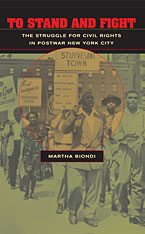
The story of the Civil Rights Movement typically begins with the Montgomery bus boycott of 1955 and culminates with the 1965 voting rights struggle in Selma. But as Martha Biondi shows, a grassroots struggle for racial equality in the urban North began a full ten years before the rise of the movement in the South. This story is an essential first chapter, not only to the southern movement that followed, but to the riots that erupted in northern and western cities just as the Civil Rights Movement was achieving major victories.
Biondi tells the story of African Americans who mobilized to make the war against fascism a launching pad for a postwar struggle against white supremacy at home. Rather than seeking integration in the abstract, Black New Yorkers demanded first-class citizenship—jobs for all, affordable housing, protection from police violence, access to higher education, and political representation. This powerful local push for economic and political equality met broad resistance, yet managed to win several landmark laws barring discrimination and segregation.
To Stand and Fight demonstrates how Black New Yorkers launched the modern civil rights struggle and left a rich legacy.

Graeme D. Bird examines a small group of early papyrus manuscripts of Homer’s Iliad, known as the Ptolemaic papyri, which, although fragmentary, are the oldest surviving physical evidence of the text of the Iliad, dating from the third to the first centuries BCE.
These papyri have been described as “eccentric” or even “wild” by some scholars. They differ significantly from the usual text of the Iliad, sometimes showing lines with different wording, at other times including so-called “interpolated” lines that are completely absent from our more familiar version.
Whereas some scholars denigrate these papyri because of their “eccentricity,” this book analyzes their unusual readings and shows that in fact they present authentic variations on the Homeric text, based on the variability characteristic of oral performance.


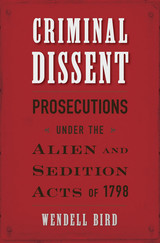
In the first complete account of prosecutions under the Alien and Sedition Acts, dozens of previously unknown cases come to light, revealing the lengths to which the John Adams administration went in order to criminalize dissent.
The campaign to prosecute dissenting Americans under the Alien and Sedition Acts of 1798 ignited the first battle over the Bill of Rights. Fearing destructive criticism and “domestic treachery” by Republicans, the administration of John Adams led a determined effort to safeguard the young republic by suppressing the opposition.
The acts gave the president unlimited discretion to deport noncitizens and made it a crime to criticize the president, Congress, or the federal government. In this definitive account, Wendell Bird goes back to the original federal court records and the papers of Secretary of State Timothy Pickering and finds that the administration’s zeal was far greater than historians have recognized. Indeed, there were twice as many prosecutions and planned deportations as previously believed. The government went after local politicians, raisers of liberty poles, and even tavern drunks but most often targeted Republican newspaper editors, including Benjamin Franklin’s grandson. Those found guilty were sent to prison or fined and sometimes forced to sell their property to survive. The Federalists’ support of laws to prosecute political opponents and opposition newspapers ultimately contributed to the collapse of the party and left a large stain on their record.
The Alien and Sedition Acts launched a foundational debate on press freedom, freedom of speech, and the legitimacy of opposition politics. The result was widespread revulsion over the government’s attempt to deprive Americans of their hard-won liberties. Criminal Dissent is a potent reminder of just how fundamental those rights are to a stable democracy.
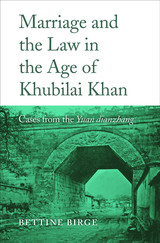
The Mongol conquest of China in the thirteenth century and Khubilai Khan’s founding of the Yuan dynasty brought together under one government people of different languages, religions, and social customs. Chinese law evolved rapidly to accommodate these changes, as reflected in the great compendium Yuan dianzhang (Statutes and Precedents of the Yuan Dynasty). The records of legal cases contained in this seminal text, Bettine Birge shows, paint a portrait of medieval Chinese family life—and the conflicts that arose from it—that is unmatched by any other historical source.
Marriage and the Law in the Age of Khubilai Khan reveals the complex, sometimes contradictory inner workings of the Mongol-Yuan legal system, seen through the prism of marriage disputes in chapter eighteen of the Yuan dianzhang, which has never before been translated into another language. Birge’s meticulously annotated translation clarifies the meaning of terms and passages, some in a hybrid Sino-Mongolian language, for specialists and general readers alike. The text includes court testimony—recorded in the vivid vernacular of people from all social classes—in lawsuits over adultery, divorce, rape, wife-selling, marriages of runaway slaves, and other conflicts. It brings us closer than any other source to the actual Mongolian speech of Khubilai and the great khans who succeeded him as they struggled to reconcile very different Mongol, Muslim, and Chinese legal traditions and confront the challenges of ruling a diverse polyethnic empire.
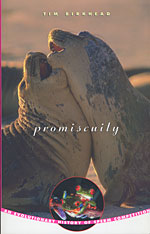
Males are promiscuous and ferociously competitive. Females--both human and of other species--are naturally monogamous. That at least is what the study of sexual behavior after Darwin assumed, perhaps because it was written by men. Only in recent years has this version of events been challenged. Females, it has become clear, are remarkably promiscuous and have evolved an astonishing array of strategies, employed both before and after copulation, to determine exactly who will father their offspring.
Tim Birkhead reveals a wonderful world in which males and females vie with each other as they strive to maximize their reproductive success. Both sexes have evolved staggeringly sophisticated ways to get what they want--often at the expense of the other. He introduces us to fish whose first encounter locks them together for life in a perpetual sexual embrace; hermaphrodites who "joust" with their reproductive organs, each trying to inseminate the other without being inseminated; and tiny flies whose seminal fluid is so toxic that it not only destroys the sperm of rival males but eventually kills the female. He explores the long and tortuous road leading to our current state of knowledge, from Aristotle's observations on chickens, to the first successful artificial insemination in the seventeenth century, to today's ingenious molecular markers for assigning paternity. And he shows how much human behavior--from the wife-sharing habits of Inuit hunters to Charlie Chaplin's paternity case--is influenced by sperm competition.
Lucidly written and lavishly illustrated, with a wealth of fascinating detail and vivid examples, Promiscuity is the ultimate guide to the battle of the sexes.

An understanding of the developments in classical analysis during the nineteenth century is vital to a full appreciation of the history of twentieth-century mathematical thought. It was during the nineteenth century that the diverse mathematical formulae of the eighteenth century were systematized and the properties of functions of real and complex variables clearly distinguished; and it was then that the calculus matured into the rigorous discipline of today, becoming in the process a dominant influence on mathematics and mathematical physics.
This Source Book, a sequel to D. J. Struik’s Source Book in Mathematics, 1200–1800, draws together more than eighty selections from the writings of the most influential mathematicians of the period. Thirteen chapters, each with an introduction by the editor, highlight the major developments in mathematical thinking over the century. All material is in English, and great care has been taken to maintain a high standard of accuracy both in translation and in transcription. Of particular value to historians and philosophers of science, the Source Book should serve as a vital reference to anyone seeking to understand the roots of twentieth-century mathematical thought.
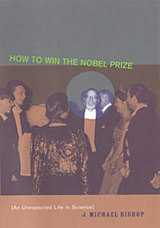
In 1989 Michael Bishop and Harold Varmus were awarded the Nobel Prize for their discovery that normal genes under certain conditions can cause cancer. In this book, Bishop tells us how he and Varmus made their momentous discovery. More than a lively account of the making of a brilliant scientist, How to Win the Nobel Prize is also a broader narrative combining two major and intertwined strands of medical history: the long and ongoing struggles to control infectious diseases and to find and attack the causes of cancer.
Alongside his own story, that of a youthful humanist evolving into an ambivalent medical student, an accidental microbiologist, and finally a world-class researcher, Bishop gives us a fast-paced and engrossing tale of the microbe hunters. It is a narrative enlivened by vivid anecdotes about our deadliest microbial enemies--the Black Death, cholera, syphilis, tuberculosis, malaria, smallpox, HIV--and by biographical sketches of the scientists who led the fight against these scourges.
Bishop then provides an introduction for nonscientists to the molecular underpinnings of cancer and concludes with an analysis of many of today's most important science-related controversies--ranging from stem cell research to the attack on evolution to scientific misconduct. How to Win the Nobel Prize affords us the pleasure of hearing about science from a brilliant practitioner who is a humanist at heart. Bishop's perspective will be valued by anyone interested in biomedical research and in the past, present, and future of the battle against cancer.


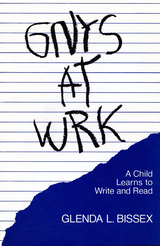
When he was five and a half years old, Paul Bissex wrote and posted this sign over his workbench: DO NAT DSTRB GNYS AT WRK. The “work” from which this “genius” refused to be “disturbed” was the work typical of all children, namely, the task of learning how to write and read. In Gnys at Wrk, Glenda Bissex goes far beyond the chronicle of her son’s accomplishment to provide the first in-depth case study of a child’s confrontation with written language, rich in revelations about the nature and processes of the mind.
Paul begins by writing notes in a system of his own invention—like IEAVGAWNTOOTHESTOR for “I have gone to the store”—and this system becomes more elaborate as he goes on to create stories, games and signs. Eventually, the system merges with conventional written English as Paul learns to separate words and to associate letters not with their names but with sets of possible sounds.
Glenda Bissex shows how the evolution of Paul’s writing ability is closely intertwined with his reading development—in Paul’s own words, “once you can write a word you can read it.“ She also makes an intriguing comparison between Paul’s schoolwork and his endeavors at home, and explores the influence of his personal interests and world view on his facility with words. Her study is a unique, detailed account of the “genius” that is, quite simply, the human capacity for language.

Mute in life as in death, peasants of remote history rarely speak to us in their own voices. But Thomas Bisson’s engagement with the records of several hundred twelfth-century people of rural Catalonia enables us to hear these voices. The peasants’ allegations of abuse while in the service of their common lord the Count of Barcelona and his son the King reveal a unique perspective on the meaning of power both by those who felt and feared it, and by those who wielded it. These records—original parchments, dating much earlier than other comparable records of European peasant life—name peasants in profusion and relate some of their stories.
Bisson describes these peasants socially and culturally, showing how their experience figured in a wider crisis of power from the twelfth century. His compassionate history considers demography, naming patterns, gender, occupational identities, and habitats, as well as power, coercion, and complaint, and the moralities of faith, honor, and shame. He concludes with reflections on the historical meanings of violence and suffering.
This rich contribution to medieval social and cultural history and peasant studies suggests important resources and ideas for historians and anthropologists.

The twenty-five poems and eleven metrical charms in this Old English volume offer tantalizing insights into the mental landscape of the Anglo-Saxons. The Wanderer and The Seafarer famously combine philosophical consolation with introspection to achieve a spiritual understanding of life as a journey. The Wife’s Lament, The Husband’s Message, and Wulf and Eadwacer direct a subjective lyrical intensity on the perennial themes of love, separation, and the passion for vengeance. From suffering comes wisdom, and these poems find meaning in the loss of fortune and reputation, exile, and alienation. “Woe is wondrously clinging; clouds glide,” reads a stoic, matter-of-fact observation in Maxims II on nature’s indifference to human suffering. Another form of wisdom emerges in the form of folk remedies, such as charms to treat stabbing pain, cysts, childbirth, and nightmares of witch-riding caused by a dwarf. The enigmatic dialogues of Solomon and Saturn combine scholarly erudition and proverbial wisdom. Learning of all kinds is celebrated, including the meaning of individual runes in The Rune Poem and the catalog of legendary heroes in Widsith.
This book is a welcome complement to the previously published DOML volume Old English Shorter Poems, Volume I: Religious and Didactic.

This book offers a systematic, comprehensive analysis of the rise and partial decline of racial segregation as an issue in southern electoral politics throughout the entire South over the third quarter of the twentieth century. The first comparative examination of a white political elite, the study draws upon an extraordinary breadth of data: 80 governorships, over 250 candidates, six “waves” of elections for each of the eleven southern states from 1950 to 1973.
By classifying candidates for the southern governorships according to their campaign stances on racial segregation, Earl Black maps out the changing racial attitudes of white office seekers over a critical period in southern history—the time now referred to as the Second Reconstruction. He shows that, largely because of Federal pressures, segregationist orientations have increasingly been replaced by nonsegregationist perspectives, and that the decline of segregationist rhetoric has been more evident in the peripheral south than in the deep south. Specific areas include: the segregation issue in the early 1950s; state-by-state summaries of the segregation issue after 1954; and the relationship between the candidates' campaign platform on race and their ability to run successfully at consecutive stages of the electoral process.
Black's conclusion that “stateways” can alter “folkways” is well-reasoned and persuasive. Accessible to all readers interested in public affairs, Southern Governors and Civil Rights makes a significant contribution to the literature on the consequences of national intervention to change southern racial attitudes.
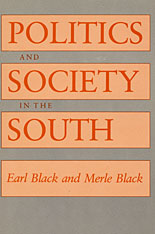
This wide-ranging examination of the “newest” South is a leading candidate to replace the classic work by V. O. Key, now two generations old. Politics and Society in the South is a systematic interpretation of the most important national and state tendencies in southern politics since 1920. The authors begin by describing the salient features of the old southern politics, against which they then depict the emergence of the new South: the changing composition of the population, the growth of industry and cities, economic diversification, and the rise of an urban middle class. A major component of the greatest southern transformation since the Civil War is the altered status of blacks from a disfranchised underclass to a franchised citizenry, a change that the authors discuss in all its ramifications. The decline of the Democratic Party is charted and related to the rise of the black vote and the transitional attitudes of white southerners. Finally, regional trends in presidential, senatorial, and gubernatorial politics are set forth, and the overall political directions that are still reshaping southern politics and creating a two-party system for the first time are defined.
The authors contend that, notable improvements in race relations notwithstanding, the central tendencies in southern politics are primarily established by the values, beliefs, and objectives of the expanding white urban middle class. This is the crucible for a more competitive two-party politics that is emerging in the South.
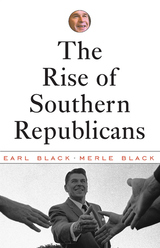
The transformation of Southern politics over the past fifty years has been one of the most significant developments in American political life. The emergence of formidable Republican strength in the previously solid Democratic South has generated a novel and highly competitive national battle for control of Congress. Tracing the slow and difficult rise of Republicans in the South over five decades, Earl and Merle Black tell the remarkable story of political upheaval.
The Rise of Southern Republicans provides a compelling account of growing competitiveness in Southern party politics and elections. Through extraordinary research and analysis, the authors track Southern voters' shifting economic, cultural, and religious loyalties, black/white conflicts and interests during and after federal civil rights intervention, and the struggles and adaptations of congressional candidates and officials.
A newly competitive South, the authors argue, means a newly competitive and revitalized America. The story of how the South became a two-party region is ultimately the story of two-party politics in America at the end of the twentieth century. Earl and Merle Black have written a bible for anyone who wants to understand regional and national congressional politics over the past half-century. Because the South is now at the epicenter of Republican and Democratic strategies to control Congress, The Rise of Southern Republicans is essential to understanding the dynamics of current American politics.

Once again a southern governor has shown Democrats the road to the White House. As a native southerner, President Bill Clinton has the opportunity to rebuild Democratic strength in the region. For the Republicans, carrying the entire South still remains a crucial imperative.
The Vital South is the first book to chronicle the massive shift of southern electoral power to Republican presidential candidates, while also showing how Democrats can again become competitive in the region. Deftly combining political narrative, in-depth analysis, and telling anecdotes, this book will be a definitive source on southern presidential politics for years to come.

The generations of Britons living through the reign of George III saw basic changes in economic and social structure: industrial revolution, agricultural revolution, demographic revolution. Romanticism displaced classicism. The religious and spiritual life of the nation changed dramatically. The rise of the mass constituency, the extension of political consensus, proved the salient new political fact. Traditional institutions and relationships were not impervious to change, but extraparliarmentary political organizations forced the pace. They reflected the interests of the community far more closely than the traditional, fragmented political factions. National extraparliamentary political organizations attempted, in parliamentary constituencies, to secure the election of members pledged to a specific program. Potential supporters were organized, after a fashion, in parliament. This is the nucleus of modern party organization, platform, and propaganda.
Mr. Black examines a number of these associations—their motives, their leaders, their opponents, their means of expression and operation, their accomplishments and failures. Names such as Wilkes, Wyvill, Gordon, Jebb, and Reeves are found in cooperation with and opposition to Rockingham, Pitt, Fox, and North. Organizations such as the Associated Counties; the Protestant Association; the Society for the Commemoration of the Glorious Revolution; and the Association for the Preservation of Liberty and Property against Republicans and Levellers are represented in this narrative of eighteenth-century political history.
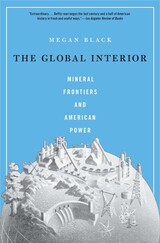
Winner of the George Perkins Marsh Prize
Winner of the Stuart L. Bernath Prize
Winner of the W. Turrentine Jackson Award
Winner of the British Association of American Studies Prize
“Extraordinary…Deftly rearranges the last century and a half of American history in fresh and useful ways.”
—Los Angeles Review of Books
“A smart, original, and ambitious book. Black demonstrates that the Interior Department has had a far larger, more invasive, and more consequential role in the world than one would expect.”
—Brian DeLay, author of War of a Thousand Deserts
When considering the story of American power, the Department of the Interior rarely comes to mind. Yet it turns out that a government agency best known for managing natural resources and operating national parks has constantly supported America’s imperial aspirations.
Megan Black’s pathbreaking book brings to light the surprising role Interior has played in pursuing minerals around the world—on Indigenous lands, in foreign nations, across the oceans, even in outer space. Black shows how the department touted its credentials as an innocuous environmental-management organization while quietly satisfying America’s insatiable demand for raw materials. As presidents trumpeted the value of self-determination, this almost invisible outreach gave the country many of the benefits of empire without the burden of a heavy footprint. Under the guise of sharing expertise with the underdeveloped world, Interior scouted tin sources in Bolivia and led lithium surveys in Afghanistan. Today, it promotes offshore drilling and even manages a satellite that prospects for Earth’s resources from outer space.
“Offers unprecedented insights into the depth and staying power of American exceptionalism…as generations of policymakers sought to extend the reach of U.S. power globally while emphatically denying that the United States was an empire.”
—Penny Von Eschen, author of Satchmo Blows Up the World
“Succeeds in showing both the central importance of minerals in the development of American power and how the realities of empire could be obscured through a focus on modernization and the mantra of conservation.”
—Ian Tyrrell, author of Crisis of the Wasteful Nation


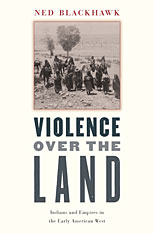
American Indians remain familiar as icons, yet poorly understood as historical agents. In this ambitious book that ranges across Utah, Nevada, New Mexico, Colorado, and eastern California (a region known as the Great Basin), Ned Blackhawk places Native peoples squarely at the center of a dynamic and complex story as he chronicles two centuries of Indian and imperial history that profoundly shaped the American West.
On the distant margins of empire, Great Basin Indians increasingly found themselves engulfed in the chaotic storms of European expansion and responded in ways that refashioned themselves and those around them. Focusing on Ute, Paiute, and Shoshone Indians, Blackhawk illuminates this history through a lens of violence, excavating the myriad impacts of colonial expansion. Brutal networks of trade and slavery forged the Spanish borderlands, and the use of violence became for many Indians a necessary survival strategy, particularly after Mexican Independence when many became raiders and slave traffickers. Throughout such violent processes, these Native communities struggled to adapt to their changing environments, sometimes scoring remarkable political ends while suffering immense reprisals.
Violence over the Land is a passionate reminder of the high costs that the making of American history occasioned for many indigenous peoples, written from the vantage point of an Indian scholar whose own family history is intimately bound up in its enduring legacies.
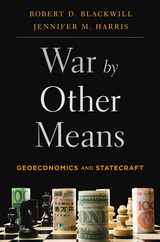
A Foreign Affairs Best Book of 2016
Today, nations increasingly carry out geopolitical combat through economic means. Policies governing everything from trade and investment to energy and exchange rates are wielded as tools to win diplomatic allies, punish adversaries, and coerce those in between. Not so in the United States, however. America still too often reaches for the gun over the purse to advance its interests abroad. The result is a playing field sharply tilting against the United States.
“Geoeconomics, the use of economic instruments to advance foreign policy goals, has long been a staple of great-power politics. In this impressive policy manifesto, Blackwill and Harris argue that in recent decades, the United States has tended to neglect this form of statecraft, while China, Russia, and other illiberal states have increasingly employed it to Washington’s disadvantage.”
—G. John Ikenberry, Foreign Affairs
“A readable and lucid primer…The book defines the extensive topic and opens readers’ eyes to its prevalence throughout history…[Presidential] candidates who care more about protecting American interests would be wise to heed the advice of War by Other Means and take our geoeconomic toolkit more seriously.
—Jordan Schneider, Weekly Standard
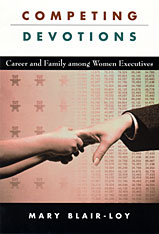
The wrenching decision facing successful women choosing between demanding careers and intensive family lives has been the subject of many articles and books, most of which propose strategies for resolving the dilemma. Competing Devotions focuses on broader social and cultural forces that create women's identities and shape their understanding of what makes life worth living.
Mary Blair-Loy examines the career paths of women financial executives who have tried various approaches to balancing career and family. The professional level these women have attained requires a huge commitment of time, energy, and emotion that seems natural to employers and clients, who assume that a career deserves single-minded allegiance. Meanwhile, these women must confront the cultural model of family that defines marriage and motherhood as a woman's primary vocation. This ideal promises women creativity, intimacy, and financial stability in caring for a family. It defines children as fragile and assumes that men lack the selflessness and patience that children's primary caregivers need. This ideal is taken for granted in much of contemporary society.
The power of these assumptions is enormous but not absolute. Competing Devotions identifies women executives who try to reshape these ideas. These mavericks, who face great resistance but are aided by new ideological and material resources that come with historical change, may eventually redefine both the nuclear family and the capitalist firm in ways that reduce work-family conflict.


In this book, based almost exclusively on original source material, Dr. Blake takes a detailed look at the public health history of the town of Boston. Historically, the author tells us, public health may be viewed as the science and art of preventing disease and promoting health through organized community activity. A significant part of this study is the insight it offers into the early attitudes toward disease and death as well as other basic political, social, and economic questions.
Dr. Blake outlines the development of public health practice from occasional emergency measures to a continuing program for the prevention and control of certain epidemic diseases. The introduction and increasing use of smallpox inoculation and later of vaccination are described and their importance evaluated. The book also discusses the further developments in the 1790s and the following two decades that resulted from a series of yellow-fever epidemics in northern seaports, including the establishment of a board of health and its efforts to prevent recurrence of this disease. The prevention of other endemic infectious diseases, though far more important in their effect on the community’s health, was largely neglected. Nevertheless, the principles of notification, isolation, and quarantine had been established and the need for governmental activity to protect the public health, for special public health officials, and for expenditure of tax money for public health purposes had been recognized.
This study, restricted in time to the period before Boston became a city (1630–1822), deals with the early years of the public health movement, a period that has been largely neglected. In comparing Boston’s experience with that of other colonies and England, Dr. Blake presents the European background in both the theory and practice of epidemiology and public health. The colonies themselves, whose differences caused many contemporaries to despair of their ever becoming a single nation, were yet bound by an essential homogeneity. “By and large they had the same language, the same religion, the same inheritance of British social and political ideals. And by and large they had the same diseases. Thus the history of public health in Boston becomes significant for the whole American experience.”

“For every problem there is a solution—simple, neat, and wrong.” H. L. Mencken made this observation years ago, and it is quoted at the beginning of Fred Blakey’s study of Florida’s phosphate industry. Few people would disagree that there is a real environmental crisis facing the world today. The cause is unrestrained growth of the population, of economies, and of the exploitation of natural resources. The author points out that this viewpoint is foreign to a people who have equated growth with progress, and bigness with goodness. Only recently have Americans conceded that their resources are not inexhaustible.
Blakey tells us that we have been bombarded with solutions to a problem that professionals view as not yet fully understood nor adequately defined. Americans face the problem not only of pollution, but of management, of values, of their very way of life. If the earth is to provide the materials for the survival of man’s society, then a prudent society must provide for an intimate understanding of the earth. Phosphorus, the topic of this study, is an element necessary for all forms of life. Long before carbon, nitrogen, or oxygen supplies become critically short, the supply of phosphorus will be exhausted. When this happens, Blakey assures us, life will end, and he demonstrates that we are losing ever-increasing amounts of this vital element every year.
This work presents a microscopic view of the ecological problems and prospects in the conservation and use of the mineral. Specifically, it is a history of the Florida phosphate industry. If the record of the Florida phosphate industry is any guide, then ecological disaster need not occur, but enlightened use of phosphorus and all other natural resources would seem to be imperative. The author tells us it is necessary to redefine some of our traditional priorities, beliefs, and values. Failure to do this indicates a willingness to continue to accept solutions that are “simple, neat—and wrong.”

Audible Punctuation focuses on the pause in Homer’s Iliad and Odyssey, both as a compositional feature and as a performative aspect of delivery, arguing for the possibilities and limits of expressing phrases in performance. Ronald Blankenborg’s analysis of metrical, rhythmical, syntactical, and phonological phrasing shows that the text of the Homeric epic allows for different options for performative pause—a phonetic phenomenon evidenced by phonology.
From the ubiquitous compositional pauses in sense and metrical surface structure, Audible Punctuation selects the pauses that, under specific phonetic circumstances, double as rests of some duration during a performance. In this way, Blankenborg identifies those places in the verses that a performer of Homeric poetry was most likely to have used as opportunities to pause. The distribution of pauses over Homer’s hexameters proves to be irregular and unpredictable because phonological phrases and grammatical clauses differ considerably in the way they terminate. The mismatch of prosodic and other levels of phrasing draws attention to the need to reassess stylistic issues, notably enjambment.
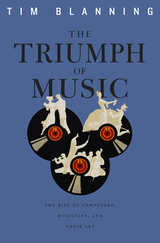
A distinguished historian chronicles the rise of music and musicians in the West from lowly balladeers to masters employed by fickle patrons, to the great composers of genius, to today’s rock stars. How, he asks, did music progress from subordinate status to its present position of supremacy among the creative arts? Mozart was literally booted out of the service of the Archbishop of Salzburg “with a kick to my arse,” as he expressed it. Yet, less than a hundred years later, Europe’s most powerful ruler—Emperor William I of Germany—paid homage to Wagner by traveling to Bayreuth to attend the debut of The Ring. Today Bono, who was touted as the next president of the World Bank in 2006, travels the world, advising politicians—and they seem to listen.
The path to fame and independence began when new instruments allowed musicians to showcase their creativity, and music publishing allowed masterworks to be performed widely in concert halls erected to accommodate growing public interest. No longer merely an instrument to celebrate the greater glory of a reigning sovereign or Supreme Being, music was, by the nineteenth century, to be worshipped in its own right. In the twentieth century, new technological, social, and spatial forces combined to make music ever more popular and ubiquitous.
In a concluding chapter, Tim Blanning considers music in conjunction with nationalism, race, and sex. Although not always in step, music, society, and politics, he shows, march in the same direction.

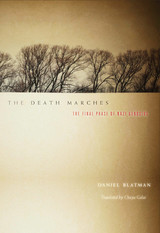
Co-winner of the Yad Vashem International Book Prize for Holocaust Research
From January 1945, in the last months of the Third Reich, about 250,000 inmates of concentration camps perished on death marches and in countless incidents of mass slaughter. They were murdered with merciless brutality by their SS guards, by army and police units, and often by gangs of civilians as they passed through German and Austrian towns and villages. Even in the bloody annals of the Nazi regime, this final death blow was unique in character and scope.
In this first comprehensive attempt to answer the questions raised by this final murderous rampage, the author draws on the testimonies of victims, perpetrators, and bystanders. Hunting through archives throughout the world, Daniel Blatman sets out to explain—to the extent that is possible—the effort invested by mankind’s most lethal regime in liquidating the remnants of the enemies of the “Aryan race” before it abandoned the stage of history. What were the characteristics of this last Nazi genocide? How was it linked to the earlier stages, the slaughter of millions in concentration camps? How did the prevailing chaos help to create the conditions that made the final murderous rampage possible?
In its exploration of a topic nearly neglected in the current history of the Shoah, this book offers unusual insight into the workings, and the unraveling, of the Nazi regime. It combines micro-historical accounts of representative massacres with an overall analysis of the collapse of the Third Reich, helping us to understand a seemingly inexplicable chapter in history.
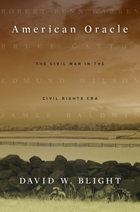
“The ghosts of the Civil War never leave us, as David Blight knows perhaps better than anyone, and in this superb book he masterfully unites two distant but inextricably bound events.”―Ken Burns
Standing on the steps of the Lincoln Memorial on August 28, 1963, a century after the signing of the Emancipation Proclamation, Martin Luther King, Jr., declared, “One hundred years later, the Negro still is not free.” He delivered this speech just three years after the Virginia Civil War Commission published a guide proclaiming that “the Centennial is no time for finding fault or placing blame or fighting the issues all over again.”
David Blight takes his readers back to the centennial celebration to determine how Americans then made sense of the suffering, loss, and liberation that had wracked the United States a century earlier. Amid cold war politics and civil rights protest, four of America’s most incisive writers explored the gulf between remembrance and reality. Robert Penn Warren, the southern-reared poet-novelist who recanted his support of segregation; Bruce Catton, the journalist and U.S. Navy officer who became a popular Civil War historian; Edmund Wilson, the century’s preeminent literary critic; and James Baldwin, the searing African-American essayist and activist—each exposed America’s triumphalist memory of the war. And each, in his own way, demanded a reckoning with the tragic consequences it spawned.
Blight illuminates not only mid-twentieth-century America’s sense of itself but also the dynamic, ever-changing nature of Civil War memory. On the eve of the 150th anniversary of the war, we have an invaluable perspective on how this conflict continues to shape the country’s political debates, national identity, and sense of purpose.
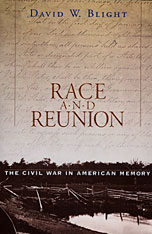
Winner of the Bancroft Prize
Winner of the Gilder Lehrman Lincoln Prize
Winner of the Merle Curti award
Winner of the Frederick Douglass Prize
No historical event has left as deep an imprint on America's collective memory as the Civil War. In the war's aftermath, Americans had to embrace and cast off a traumatic past. David Blight explores the perilous path of remembering and forgetting, and reveals its tragic costs to race relations and America's national reunion.In 1865, confronted with a ravaged landscape and a torn America, the North and South began a slow and painful process of reconciliation. The ensuing decades witnessed the triumph of a culture of reunion, which downplayed sectional division and emphasized the heroics of a battle between noble men of the Blue and the Gray. Nearly lost in national culture were the moral crusades over slavery that ignited the war, the presence and participation of African Americans throughout the war, and the promise of emancipation that emerged from the war. Race and Reunion is a history of how the unity of white America was purchased through the increasing segregation of black and white memory of the Civil War. Blight delves deeply into the shifting meanings of death and sacrifice, Reconstruction, the romanticized South of literature, soldiers' reminiscences of battle, the idea of the Lost Cause, and the ritual of Memorial Day. He resurrects the variety of African-American voices and memories of the war and the efforts to preserve the emancipationist legacy in the midst of a culture built on its denial.
Blight's sweeping narrative of triumph and tragedy, romance and realism, is a compelling tale of the politics of memory, of how a nation healed from civil war without justice. By the early twentieth century, the problems of race and reunion were locked in mutual dependence, a painful legacy that continues to haunt us today.

The monastery of Monte Cassino, founded by St. Benedict in the sixth century, was the cradle of Western monasticism. It became one of the vital centers of culture and learning in Europe. At the height of its influence, in the eleventh and early twelfth centuries, two of its abbots (including Desiderius) and one of its monks became popes, and it controlled a vast network of dependencies—churches, monasteries, villages, and farms—especially in central and southern Italy.
Herbert Bloch's study, the product of forty years of research, takes as its starting point the twelfth-century bronze doors of the basilica of the abbey, the most significant relic of the medieval structure. The panels of these doors are inscribed with a list of more than 180 of the abbey's possessions. Mr. Bloch has supplemented this roster with lists found in papal and imperial privileges and other documents. The heart of the book is a detailed investigation of the nearly 700 dependencies of Monte Cassino from the sixth to the twelfth century and beyond. No comparable study of this or any other great medieval institution has ever before been undertaken.
Ironically, it was the bombing of 1944, which destroyed the monastery, that led to an unexpected revelation: the discovery, on the reverse side of some panels of the doors, of magnificent engraved figures of patriarchs and apostles. These proved to be remnants of the church portal ordered from Constantinople by Desiderius in the eleventh century, which marked the beginning of the grandiose reconstruction of the abbey and its church, the latter to become a model for many other churches. In order to solve the riddle of the doors of Monte Cassino, Bloch has investigated other bronze doors of Byzantine origin in Italy and the doors of the great Italian master Oderisius of Benevento, as well as those of S. Clemente a Casauria and of the cathedral of Benevento. Also included is a study of the political and cultural impact of Byzantium on Monte Cassino and a chapter on Constantinus Africanus, Saracen turned monk, one of the most interesting figures in the history of medieval medicine.
The text is sumptuously illustrated with 193 plates; most of the more than 300 illustrations have never before been published. This three-volume work, with its nine detailed indexes, offers a wealth of information for scholars in many different fields.
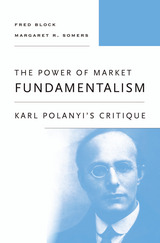
What is it about free-market ideas that give them tenacious staying power in the face of such manifest failures as persistent unemployment, widening inequality, and the severe financial crises that have stressed Western economies over the past forty years? Fred Block and Margaret Somers extend the work of the great political economist Karl Polanyi to explain why these ideas have revived from disrepute in the wake of the Great Depression and World War II, to become the dominant economic ideology of our time.
Polanyi contends that the free market championed by market liberals never actually existed. While markets are essential to enable individual choice, they cannot be self-regulating because they require ongoing state action. Furthermore, they cannot by themselves provide such necessities of social existence as education, health care, social and personal security, and the right to earn a livelihood. When these public goods are subjected to market principles, social life is threatened and major crises ensue.
Despite these theoretical flaws, market principles are powerfully seductive because they promise to diminish the role of politics in civic and social life. Because politics entails coercion and unsatisfying compromises among groups with deep conflicts, the wish to narrow its scope is understandable. But like Marx's theory that communism will lead to a "withering away of the State," the ideology that free markets can replace government is just as utopian and dangerous.
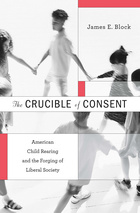
A democratic government requires the consent of its citizens. But how is that consent formed? Why should free people submit to any rule? Pursuing this question to its source for the first time, The Crucible of Consent argues that the explanation is to be found in the nursery and the schoolroom. Only in the receptive and less visible realms of childhood and youth could the necessary synthesis of self-direction and integrative social conduct—so contradictory in logic yet so functional in practice—be established without provoking reservation or resistance.
From the early postrevolutionary republic, two liberal child-rearing institutions—the family and schooling—took on a responsibility crucial to the growing nation: to produce the willing and seemingly self-initiated conformability on which the society’s claim of freedom and demand for order depended. Developing the institutional mechanisms for generating early consent required the constant transformation of child-rearing theory and practice over the course of the nineteenth century. By exploring the systematic reframing of relations between generations that resulted, this book offers new insight into the consenting citizenry at the foundation of liberal society, the novel domestic and educational structures that made it possible, and the unprecedented role created for the young in the modern world.
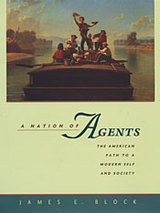
In this sweeping reinterpretation of American political culture, James Block offers a new perspective on the formation of the modern American self and society. Block roots both self and society in the concept of agency, rather than liberty, and dispenses with the national myth of the "sacred cause of liberty"--with the Declaration of Independence as its "American scripture." Instead, he recovers the early modern conception of agency as the true synthesis emerging from America's Protestant and liberal cultural foundations.
Block traces agency doctrine from its pre-Commonwealth English origins through its development into the American mainstream culture on the eve of the twentieth century. The concept of agency that prevailed in the colonies simultaneously released individuals from traditional constraints to participate actively and self-reliantly in social institutions, while confining them within a new set of commitments. Individual initiative was now firmly bounded by the modern values and ends of personal Protestant religiosity and collective liberal institutional authority. As Block shows, this complex relation of self to society lies at the root of the American character.
A Nation of Agents is a new reading of what the "first new nation" did and did not achieve. It will enable us to move beyond long-standing national myths and grasp both the American achievement and its legacy for modernity.
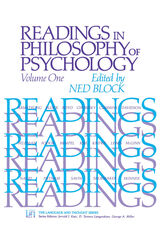
In this introduction to the philosophical problems underlying the modern study of mind and behavior, Ned Block has collected the most important papers by the major figures in the field. He provides the only central reference work now available for scholars and students in this growing area of inquiry.
Volume I covers general approaches to the study of the mind: behaviorism, reductionism, and functionalism. Volume II addresses the central topics in modern cognitive science: mental representation, imagery, grammar and innate ideas.


News over the Wires tells the story of the development of the news wire service as a business operation strategically positioned between the telegraph industry and the press. This unique history of telegraphic news gathering and news flow evaluates the effect of the innovative technology on the evolution of the concept of news and journalistic practices. It also addresses problems of technological innovation and diffusion. Menahem Blondheim's main concern, however, is the development of oligopoly in business and the control revolution in American society. He traces the discovery of timely news as a commodity, presenting a lively and detailed account of the emergence of the New York Associated Press (AP) as the first private sector national monopoly in the United States and Western Union as the first industrial one.
The book assembles, in a narrative parade of compelling personalities and colorful episodes, a wide-ranging body of primary sources, many of them previously untapped. It reconstructs the career of AP's maverick manager, Daniel H. Craig, and highlights his achievements as one of the most creative and effective, if least appreciated, of America's great system builders. The Associated Press and Western Union provide a novel perspective on processes of modernization and national integration in America. News over the Wires demonstrates the significance of the monopolistic structure of the news business and its important impact on economic development, on the political process, and on social integration in general.
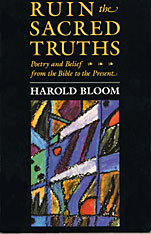

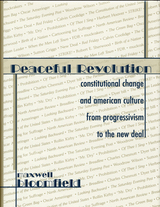
Although Americans claim to revere the Constitution, relatively few understand its workings. Its real importance for the average citizen is as an enduring reminder of the moral vision that shaped the nation's founding. Yet scholars have paid little attention to the broader appeal that constitutional idealism has always made to the American imagination through publications and films. Maxwell Bloomfield draws upon such neglected sources to illustrate the way in which media coverage contributes to major constitutional change.
Successive generations have sought to reaffirm a sense of national identity and purpose by appealing to constitutional norms, defined on an official level by law and government. Public support, however, may depend more on messages delivered by the popular media. Muckraking novels, such as Upton Sinclair's The Jungle (1906), debated federal economic regulation. Woman suffrage organizations produced films to counteract the harmful gender stereotypes of early comedies. Arguments over the enforcement of black civil rights in the Civil Rights Cases and Plessy v. Ferguson took on new meaning when dramatized in popular novels.
From the founding to the present, Americans have been taught that even radical changes may be achieved through orderly constitutional procedures. How both elite and marginalized groups in American society reaffirmed and communicated this faith in the first three decades of the twentieth century is the central theme of this book.

After a long period of neglect and even disdain, allegory and myth in the broadest sense are coming again into their own as central tools to the understanding of literary art. The essays in this volume, ranging in time from the Middle Ages to the present and in subject from poetry to philosophy, explore the multiple interpretations of allegory, as well as the important distinctions among allegory, myth, and symbol.
Besides assisting in the understanding of particular literary works and authors, this book makes a worthy contribution to comprehension of the major role allegory plays in literature and indeed in life.
Among the nineteen essays are “‘Awaking Dream’: The Symbolic Alternative to Allegory,” by Murray Krieger; “The Modern Revival of Myth,” by James Engell; “The Two Allegories,” by J. Hillis Miller; “The ‘Rhythm of Metaphor’: Yeats, Pound, Eliot and the Unity of Image in Postsymbolist Poetry,” by Ronald Bush; and “Sartor Resartus and the Inverse Sublime: The Art of Humorous Deconstruction,” by Peter Allan Dale.




We are culturally conditioned to think of war and peace in binary terms of strict opposition. Correspondingly, we tend to focus our attention on conflict prevention or conflict resolution. But as Islands of Agreement demonstrates, peace and war are seldom polar totalities but increasingly can and do coexist within the confines of a single scenario.
Consequently, Gabriella Blum suggests that even where conflict exists, we regard it as only one dimension of an ongoing, multifaceted interstate relationship. The result is a shift in perspective away from the constricting notions of "prevention" or "resolution" toward a more holistic approach of relationship management.
This approach is especially pertinent because conflicts cannot always be prevented or resolved. Through case studies of long-enduring rivalries--India and Pakistan, Greece and Turkey, Israel and Lebanon--Blum shows how international law and politics can function in the battlefield and in everyday life, forming a hybrid international relationship.
Through a strategy she calls "islands of agreement," Blum argues that within the most entrenched and bitter struggles, adversaries can carve out limited areas that remain safe or even prosperous amid a tide of war. These havens effectively reduce suffering and loss and allow mutually beneficial exchanges to take place, offering hope for broader accords.

This is a book about politics and politicians; about elections, lawmaking, governing, and how they work. It is also about power, its increasing concentration in American society, and its implications at home and abroad especially for those who exercise it. It is a book about the Republican Party during the period in which it developed the forces and frictions which still characterize it today. Finally, it is a book about a remarkably successful and vibrant man who contained within himself much of the best and the worst of his environment, who contributed generously to American life, who knew in his time disappointment, temptation, and pain, but also glory; a man remembered most by his intimates for the “fun of him.”
The author is in an enviable position to assess these matters. During five years as Associate Editor of The Letters of Theodore Roosevelt, he read and studied all TR's letters as well as all his published works, and delved deeply into the relevant literature of the period, including the vast material in the Congressional Record. From this rich store, John Morton Blum has drawn a new interpretation of Roosevelt the conservative, Roosevelt the professional Republican politician and Roosevelt the leader of men. He presents new material on Roosevelt's work as the manager of the Republican Party and as manager of Congress. He relates Roosevelt's roles in these situations to his conduct of foreign policy—a foreign policy so anticipatory of that of contemporary America—and to his Progressiveness—a doctrine of government with strong affinities to both the New Deal and the New Crusade.
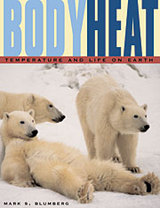
Whether you're a polar bear giving birth to cubs in an Arctic winter, a camel going days without water in the desert heat, or merely a suburbanite without air conditioning in a heat wave, your comfort and even survival depend on how well you adapt to extreme temperatures.
In this entertaining and illuminating book, biopsychologist Mark Blumberg explores the many ways that temperature rules the lives of all animals (including us). He moves from the physical principles that govern the flow of heat in and out of our bodies to the many complex evolutionary devices animals use to exploit those principles for their own benefit.
In the process Blumberg tells wonderful stories of evolutionary and scientific ingenuity--how penguins withstand Antarctic winters by huddling together by the thousands, how vulnerable embryos of many species are to extremes of temperature during their development, why people survive hour-long drowning accidents in winter but not in summer, how certain plants generate heat (the skunk cabbage enough to melt snow around it). We also hear of systems gone awry--how desert species given too much water can drink themselves into bloated immobility, why anorexics often complain of feeling cold, and why you can't sleep if the room is too hot or too cold. After reading this book, you'll never look at a thermostat in quite the same way again.

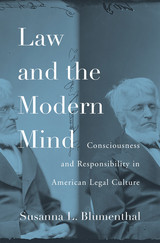
In postrevolutionary America, the autonomous individual was both the linchpin of a young nation and a threat to the founders’ vision of ordered liberty. Conceiving of self-government as a psychological as well as a political project, jurists built a republic of laws upon the Enlightenment science of the mind with the aim of producing a responsible citizenry. Susanna Blumenthal probes the assumptions and consequences of this undertaking, revealing how ideas about consciousness, agency, and accountability have shaped American jurisprudence.
Focusing on everyday adjudication, Blumenthal shows that mental soundness was routinely disputed in civil as well as criminal cases. Litigants presented conflicting religious, philosophical, and medical understandings of the self, intensifying fears of a populace maddened by too much liberty. Judges struggled to reconcile common sense notions of rationality with novel scientific concepts that suggested deviant behavior might result from disease rather than conscious choice. Determining the threshold of competence was especially vexing in litigation among family members that raised profound questions about the interconnections between love and consent. This body of law coalesced into a jurisprudence of insanity, which also illuminates the position of those to whom the insane were compared, particularly children, married women, and slaves. Over time, the liberties of the eccentric expanded as jurists came to recognize the diversity of beliefs held by otherwise reasonable persons.
In calling attention to the problematic relationship between consciousness and liability, Law and the Modern Mind casts new light on the meanings of freedom in the formative era of American law.

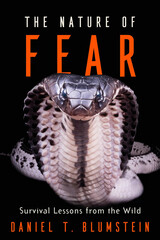
An Open Letters Review Best Book of the Year
A leading expert in animal behavior takes us into the wild to better understand and manage our fears.
Fear, honed by millions of years of natural selection, kept our ancestors alive. Whether by slithering away, curling up in a ball, or standing still in the presence of a predator, humans and other animals have evolved complex behaviors in order to survive the hazards the world presents. But, despite our evolutionary endurance, we still have much to learn about how to manage our response to danger.
For more than thirty years, Daniel Blumstein has been studying animals’ fear responses. His observations lead to a firm conclusion: fear preserves security, but at great cost. A foraging flock of birds expends valuable energy by quickly taking flight when a raptor appears. And though the birds might successfully escape, they leave their food source behind. Giant clams protect their valuable tissue by retracting their mantles and closing their shells when a shadow passes overhead, but then they are unable to photosynthesize, losing the capacity to grow. Among humans, fear is often an understandable and justifiable response to sources of threat, but it can exact a high toll on health and productivity.
Delving into the evolutionary origins and ecological contexts of fear across species, The Nature of Fear considers what we can learn from our fellow animals—from successes and failures. By observing how animals leverage alarm to their advantage, we can develop new strategies for facing risks without panic.

To read the history of ancient Greece as it has been written for centuries is to enter a thoroughly male world. This book, a comprehensive history of women in the Archaic and Classical Ages, completes our picture of ancient Greek society.
Largely excluded from any public role, the women of ancient Greece nonetheless appear in various guises in the art and writing of the period, and in legal documents. These representations, in Sue Blundell’s analysis, reveal a great deal about women’s day-to-day experience as well as their legal and economic position—and how they were regarded by men. Here are women as portrayed in Homer, in Greek lyric poetry, and by the playwrights; the female nature as depicted in medical writings and by Aristotle; representations of women in sculpture and vase paintings. This is evidence filtered through a male view: Sappho is the only female writer of antiquity much of whose work survives. Yet these sources and others such as regulations and law court speeches reveal a great deal about women’s lives and about their status as defined by law and by custom.
By examining the roles that men assigned to women, the ideals they constructed for them, and the anxieties they expressed about them, Blundell sheds light on the cultural dynamics of a male-dominated society. Lively and richly illustrated, her work offers a fresh look at women in the ancient world.

Francesco Borromini is one of the great geniuses of Baroque architecture, perhaps the greatest in inventiveness and in use of spatial effects. Here is the first book in English to survey the whole work of the master. The author, former Director of the Courtauld Institute of Art, is known internationally for his many works on French and Italian architecture and painting.
In this lucid and fully illustrated account, Anthony Blunt charts Borromini’s career and analyzes and assesses his art. Mr. Blunt tells of Borromini’s training, relating his style to that of Bernini, under whom he worked, and to the architecture from which he learned, for example Michelangelo’s. Borromini’s patrons allowed him freedom to evolve his own ideas, and his originality and imagination in inventing new architectural forms become apparent as the author studies individual commissions. His imagination was apparently limitless, but his inventions evolved in terms of rigidly controlled geometry. It is this combination of revolutionary inventiveness and intellectual control that gives Borromini’s work particular appeal in the twentieth century.

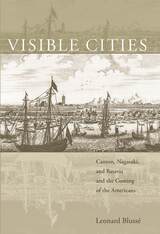
The eighteenth century witnessed the rise of the China market and the changes that resulted in global consumption patterns, from opium smoking to tea drinking. In a valuable transnational perspective, Leonard Blussé chronicles the economic and cultural transformations in East Asia through three key cities. Canton was the port of call for foreign merchants in the Qing empire. Nagasaki was the official port of Tokugawa Japan. Batavia served as the connection site between the Indian Ocean and China seas for ships of the Dutch East India Company.
The effects of global change were wrenching. The monopolies suffered challenges, trade corridors shifted, and new players appeared. Yankee traders in their fast clipper ships made great inroads. As Dutch control declined, Batavia lost its premier position. Nagasaki became a shadow of its former self. Canton, however, surged to become the foremost port of East Asia. But on the horizon were new kinds of port cities, not controlled from above and more attuned to the needs of the overseas trading network. With the establishment of the free port of Singapore and the rise of the treaty ports—Hong Kong, Shanghai, Yokohama—the nature of the China seas trade, and relations between East Asia and the West, changed forever.

Karl Marx's materialistic conception of history claimed to account for the past, confidently predicted the future, and made history itself. In analyzing the Marxian theory of social evolution, M. M. Bober closely examines the writings of Marx and his friend, Friedrich Engels, tracing the formulation of the doctrine in Capital, The Poverty of Philosophy, Civil War in France, Revolution and Counter-Revolution, The Communist Manifesto, and other of their voluminous publications. By careful, objective investigation, the author is able to present an accurate interpretation of Marx's economic and historical concepts, and he evaluates the theory in the light of actual historical development.
In the extensive revision of his authoritative study, Bober has taken full account of developments since its first publication. Unknown writings by Marx and Engels recently have been discovered; new voices have been raised in defense of and against Marxian concepts; and economic theory has changed, with the problems of the business cycle and economic calculation assuming greater prominence. Bober's critical analysis of Marx and of his influence make a valuable and timely book, of interest not merely to scholars but also to everyone who is stirred to serious reading by the present conflict of political ideologies.
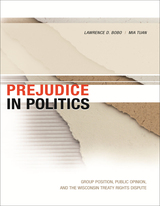
This book presents a sociological study of how and why racial prejudice against members of a minority group comes to shape what happens to important political claims and aspirations of the group. Lawrence Bobo and Mia Tuan explore a lengthy controversy surrounding the fishing, hunting, and gathering rights of the Chippewa Indians in Wisconsin. The controversy started in 1974, when two Chippewa Indians were arrested for off-reservation fishing, and persisted into the 1990s. It involved the efforts of the Chippewa to assert their traditional spearfishing rights, which met with angry, racially charged responses from whites.
Bobo and Tuan develop a "group position" perspective on racial attitudes that takes account of the complex interplay of racial stereotypes and negative group feelings as well as the vested interests, collective privileges, and political threats that form the basis of racialized political disputes. They explore whether theories that explain race politics in the case of black-white relations are applicable to understanding Indian-white relations. The book uses a carefully designed survey of public opinion to explore the dynamics of prejudice and political contestation, and to further our understanding of how and why racial prejudice enters into politics in the United States.
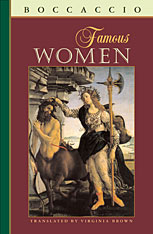

After the composition of the Decameron, and under the influence of Petrarch’s humanism, Giovanni Boccaccio (1313–1375) devoted the last decades of his life to compiling encyclopedic works in Latin. Among them is Famous Women, the first collection of biographies in Western literature devoted exclusively to women.
The 106 women whose life stories make up this volume range from the exemplary to the notorious, from historical and mythological figures to Renaissance contemporaries. In the hands of a master storyteller, these brief biographies afford a fascinating glimpse of a moment in history when medieval attitudes toward women were beginning to give way to more modern views of their potential.
Famous Women, which Boccaccio continued to revise and expand until the end of his life, became one of the most popular works in the last age of the manuscript book, and had a signal influence on many literary works, including Chaucer’s Canterbury Tales and Castiglione’s Courtier. This edition presents the first English translation based on the autograph manuscript of the Latin.
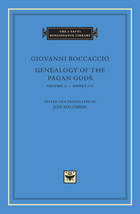
Giovanni Boccaccio’s Genealogy of the Pagan Gods is an ambitious work of humanistic scholarship whose goal is to plunder ancient and medieval literary sources so as to create a massive synthesis of Greek and Roman mythology. The work also contains a famous defense of the value of studying ancient pagan poetry in a Christian world.
The complete work in fifteen books contains a meticulously organized genealogical tree identifying approximately 950 Greco-Roman mythological figures. The scope is enormous: 723 chapters include over a thousand citations from two hundred Greek, Roman, medieval, and Trecento authors. Throughout the Genealogy, Boccaccio deploys an array of allegorical, historical, and philological critiques of the ancient myths and their iconography.
Much more than a mere compilation of pagan myths, the Genealogy incorporates hundreds of excerpts from and comments on ancient poetry, illustrative of the new spirit of philological and cultural inquiry emerging in the early Renaissance. It is at once the most ambitious work of literary scholarship of the early Renaissance and a demonstration to contemporaries of the moral and cultural value of studying ancient poetry. This is the first volume of a projected three-volume set of Boccaccio’s complete Genealogy.

Genealogy of the Pagan Gods by Giovanni Boccaccio (1313–1375) is an ambitious work of humanistic scholarship whose goal is to plunder ancient and medieval literary sources so as to create a massive synthesis of Greek and Roman mythology. The work also contains a famous defense of the value of studying ancient pagan poetry in a Christian world.
The complete work in fifteen books contains a meticulously organized genealogical tree identifying approximately 950 Greco-Roman mythological figures. The scope is enormous: 723 chapters include over a thousand citations from 200 Greek, Roman, medieval, and Trecento authors. Throughout the Genealogy, Boccaccio deploys an array of allegorical, historical, and philological critiques of the ancient myths and their iconography.
Much more than a mere compilation of pagan myths, the Genealogy incorporates hundreds of excerpts from and comments on ancient poetry, illustrative of the new spirit of philological and cultural inquiry emerging in the early Renaissance. It is at once the most ambitious work of literary scholarship of the early Renaissance and a demonstration to contemporaries of the moral and cultural value of studying ancient poetry.

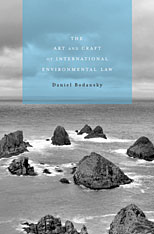
International environmental law is often closer to home than we know, affecting the food we eat, the products we buy, and even the air we breathe. Drawing on more than two decades of experience as a government negotiator, consultant, and academic, Daniel Bodansky brings a real-world perspective on the processes by which international environmental law develops, and influences the behavior of state and non-state actors.
In self-contained chapters that offer a clear guide to a complex field, Bodansky answers fundamental questions about how international environmental law works. What role can law play in addressing global environmental challenges such as climate change, ozone depletion, and loss of biodiversity? How do environmental problems come onto the international agenda? What are the obstacles to international cooperation, and what can international environmental law do to address them? How do international rules develop? How are they put into practice and what makes them effective?


When Edgar Bodenheimer’s book, Jurisprudence: The Philosophy and Method of the Law, was published in 1962, it received extraordinary reviews. It was called by one commentator “a profoundly scholarly, clearly written and thoroughly unpretentious contribution to the literature of jurisprudence.” Because there have been significant developments in analytical jurisprudence and in the legal philosophy of values, Bodenheimer has brought his book up to date.
Part I now includes a discussion of important recent contributions to jurisprudence. Part II has been largely rewritten to give more extensive consideration to the psychological roots of the need for order and quest for justice, the conceptual scope and substantive components of the notion of justice, and the criteria for validity of the law. Part III of Bodenheimer’s study is concerned with the problems of legal method and the modes of legal reasoning.

Iblīs, the character in the Qur’an who refuses God’s command to bow to Adam and is punished by eviction from heaven, is commonly depicted as a fiendish character no different from Satan. However, some Sufi stories describe Iblīs as the ultimate monotheist, a lover of God, but tragically rejected. This volume seeks the origins of this alternative Iblīs within the Qur’an itself, by looking at each of the seven Qur’anic versions of the Iblīs story as a unique rendering of the basic narrative. Whitney Bodman finds that the likely earliest version of the Iblīs story presents him as a tragic figure, an elder sibling of Adam unjustly displaced from God’s favor. Subsequent renderings present an Iblīs more hostile to humanity, and in the last two abbreviated versions Iblīs becomes an incidental figure in the extended story of Adam.
In modern Arab literature the character of Iblīs is deployed to reveal tragic dimensions of modern life. Although it is often said that there is no place for tragedy in Islam, Bodman’s careful examination of the Iblīs story shows that the tragic exists even in the Qur’an and forms part of the vision of medieval Sufi mystics and modern social critics alike.

On April 20, 2010, the crew of the floating drill rig Deepwater Horizon lost control of the Macondo oil well forty miles offshore in the Gulf of Mexico. Escaping gas and oil ignited, destroying the rig, killing eleven crew members, and injuring dozens more. The emergency spiraled into the worst human-made economic and ecological disaster in Gulf Coast history.
Senior systems engineers Earl Boebert and James Blossom offer the most comprehensive account to date of BP’s Deepwater Horizon oil spill. Sifting through a mountain of evidence generated by the largest civil trial in U.S. history, the authors challenge the commonly accepted explanation that the crew, operating under pressure to cut costs, made mistakes that were compounded by the failure of a key safety device. This explanation arose from legal, political, and public relations maneuvering over the billions of dollars in damages that were ultimately paid to compensate individuals and local businesses and repair the environment. But as this book makes clear, the blowout emerged from corporate and engineering decisions which, while individually innocuous, combined to create the disaster.
Rather than focusing on blame, Boebert and Blossom use the complex interactions of technology, people, and procedures involved in the high-consequence enterprise of offshore drilling to illustrate a systems approach which contributes to a better understanding of how similar disasters emerge and how they can be prevented.

Published annually, the journal Dumbarton Oaks Papers was founded in 1941 for the publication of articles relating to Byzantine civilization.
In this issue: Audrey Becker, “Verbal and Nonverbal Diplomatic Communication at the Imperial Court of Constantinople (fifth–sixth Centuries)”; Alexandra Wassiliou-Seibt and Andreas Gkoutzioukostas, “The Origin and the Members of the Kamytzes Family: A Contribution to Byzantine Prosopography”; Michael Zellmann-Rohrer, “‘Psalms Useful for Everything’: Byzantine and Post-Byzantine Manuals for the Amuletic Use of the Psalter”; Raymond Van Dam, “Eastern Aristocracies and Imperial Courts: Constantine’s Half-Brother, Licinius’s Prefect, and Egyptian Grain”; Daniel Caner, “Not a Hospital but a Leprosarium: Basil’s Basilias and an Early Byzantine Concept of the Deserving Poor”; Paul Botley, “Greek Literature in Exile: The Books of Andronicus Callistus, 1475–1476”; Aude Busine, “The Dux and the Nun: Hagiography and the Cult of Artemios and Febronia in Constantinople”; Benjamin Garstad, “Dionysiac and Christian Elements in the Lysos Episode in the Greek Alexander Romance (β rec.).”


This book, an in-depth study of Nationalist tariff policy, fundamentally challenges the widely accepted idea that the key to the Communist seizure of power in China lay in the incompetence of Chiang Kai-shek’s Nationalist government. It argues instead that during the second Sino-Japanese War, China’s international trade, the Nationalist government’s tariff revenues, and hence its fiscal policy and state-making project all collapsed.
Because tariffs on China’s international trade produced the single greatest share of central government revenue during the Nanjing decade, the political existence of the Nationalist government depended on tariff revenue. Therefore, Chinese economic nationalism, both at the official and popular levels, had to be managed carefully so as not to jeopardize the Nationalist government’s income. Until the outbreak of war in 1937, the Nationalists’ management of international trade and China’s government finances was largely successful in terms of producing increasing and sustainable revenues. Within the first year of war, however, the Nationalists lost territories producing 80 percent of tariff revenue. Hence, government revenue declined just as war-related expenditure increased, and the Nationalist government had to resort to more rapacious forms of revenue extraction—a decision that had disastrous consequences for both its finances and its political viability.

Athens in the fifth century B.C. offers a striking picture: the first democracy in history; the first empire created and ruled by a Greek city; and a flourishing of learning, philosophical thought, and visual and performing arts so rich as to leave a remarkable heritage for Western civilization. To what extent were these three parallel developments interrelated? An international group of fourteen scholars expert in different fields explores here the ways in which the fifth-century "cultural revolution" depended on Athenian democracy and the ways it was influenced by the fact that Athens was an imperial city.
The authors bring to this analysis their individual areas of expertise--in the visual arts, poetry and drama, philosophy, archaeology, religion, and social, economic, and political history--and a variety of theoretical approaches. The product of a colloquium at Harvard's Center for Hellenic Studies in Washington, D.C., Democracy, Empire, and the Arts in Fifth-Century Athens sheds new light on a much debated question that has wide implications. The book is illustrated and enriched by a comprehensive bibliography on the subject.
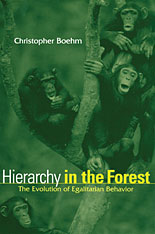
Are humans by nature hierarchical or egalitarian? Hierarchy in the Forest addresses this question by examining the evolutionary origins of social and political behavior. Christopher Boehm, an anthropologist whose fieldwork has focused on the political arrangements of human and nonhuman primate groups, postulates that egalitarianism is in effect a hierarchy in which the weak combine forces to dominate the strong.
The political flexibility of our species is formidable: we can be quite egalitarian, we can be quite despotic. Hierarchy in the Forest traces the roots of these contradictory traits in chimpanzee, bonobo, gorilla, and early human societies. Boehm looks at the loose group structures of hunter-gatherers, then at tribal segmentation, and finally at present-day governments to see how these conflicting tendencies are reflected.
Hierarchy in the Forest claims new territory for biological anthropology and evolutionary biology by extending the domain of these sciences into a crucial aspect of human political and social behavior. This book will be a key document in the study of the evolutionary basis of genuine altruism.

A Christian polymath embraces reason against misfortune in poetry and prose.
Boethius (Boetius)—Anicius Manlius Severinus—Roman statesman and philosopher (ca. AD 480–524), was son of Flavius Manlius Boetius, after whose death he was looked after by several men, especially Memmius Symmachus. He married Symmachus’ daughter, Rusticiana, by whom he had two sons. All three men rose to high honors under Theodoric the Ostrogoth, but Boethius fell from favor, was tried for treason, wrongly condemned, and imprisoned at Ticinum (Pavia), where he wrote his renowned Consolation of Philosophy. He was put to death in 524, to the great remorse of Theodoric. Boethius was revered as if he were a saint and his bones were removed in 996 to the Church of S. Pietro in Ciel d’Oro, and later to the Cathedral. The tower in Pavia where he was imprisoned is still venerated.
Boethius was author of Latin translations of Aristotle, commentaries on various philosophical works, original works on logic, five books on music, and other works. His Consolation of Philosophy is the last example of purely literary Latin of ancient times—a mingling of alternate dialogue and poems. His Theological Tractates are also included in this volume.
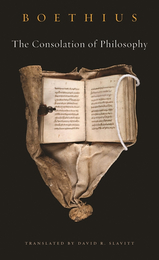
In this highly praised new translation of Boethius’s The Consolation of Philosophy, David R. Slavitt presents a graceful, accessible, and modern version for both longtime admirers of one of the great masterpieces of philosophical literature and those encountering it for the first time. Slavitt preserves the distinction between the alternating verse and prose sections in the Latin original, allowing us to appreciate the Menippian parallels between the discourses of literary and logical inquiry. His prose translations are lively and colloquial, conveying the argumentative, occasionally bantering tone of the original, while his verse translations restore the beauty and power of Boethius’s poetry. The result is a major contribution to the art of translation.
Those less familiar with Consolation may remember it was written under a death sentence. Boethius (c. 480–524), an Imperial official under Theodoric, Ostrogoth ruler of Rome, found himself, in a time of political paranoia, denounced, arrested, and then executed two years later without a trial. Composed while its author was imprisoned, cut off from family and friends, it remains one of Western literature’s most eloquent meditations on the transitory nature of earthly belongings, and the superiority of things of the mind. In an artful combination of verse and prose, Slavitt captures the energy and passion of the original. And in an introduction intended for the general reader, Seth Lerer places Boethius’s life and achievement in context.
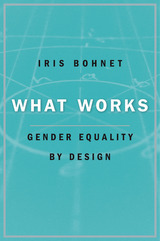
Shortlisted for the Financial Times and McKinsey Business Book of the Year Award
A Financial Times Best Business Book of the Year
A Times Higher Education Book of the Week
Best Business Book of the Year, 800-CEO-READ
Gender equality is a moral and a business imperative. But unconscious bias holds us back, and de-biasing people’s minds has proven to be difficult and expensive. By de-biasing organizations instead of individuals, we can make smart changes that have big impacts. Presenting research-based solutions, Iris Bohnet hands us the tools we need to move the needle in classrooms and boardrooms, in hiring and promotion, benefiting businesses, governments, and the lives of millions.
“Bohnet assembles an impressive assortment of studies that demonstrate how organizations can achieve gender equity in practice…What Works is stuffed with good ideas, many equally simple to implement.”
—Carol Tavris, Wall Street Journal
“A practical guide for any employer seeking to offset the unconscious bias holding back women in organizations, from orchestras to internet companies.”
—Andrew Hill, Financial Times


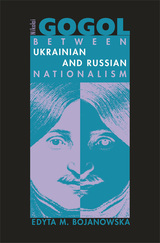
No other writer captured the fraught relations between Ukrainian and Russian nationalisms with as much complexity and lasting relevance as Nikolai Gogol. This pathbreaking book illuminates the deep cultural stakes of today’s geopolitical conflict.
The nineteenth-century author Nikolai Gogol occupies a key place in the Russian cultural pantheon as an ardent champion of Russian nationalism. Indeed, he created the nation’s most famous literary icon: Russia as a rushing carriage, full of elemental energy and limitless potential.
In a pathbreaking book, Edyta M. Bojanowska topples the foundations of this russocentric myth of the Ukrainian-born writer, a myth that has also dominated his Western image. She reveals Gogol’s creative engagement with Ukrainian nationalism and calls attention to the subversive irony and ambiguity in his writings on Russian themes. While in early writings Gogol endowed Ukraine with cultural wholeness and a heroic past, his Russia appears bleak and fractured. Russian readers resented this unflattering contrast and called upon him to produce a brighter vision of Russia. Gogol struggled to satisfy their demands but ultimately failed.
In exploring Gogol’s fluctuating nationalist commitments, this book traces the connections and tensions between the Russian and Ukrainian nationalist paradigms in his work, and situates both in the larger imperial context. In addition to radically new interpretations of Gogol’s texts, Bojanowska offers a comprehensive analysis of his reception by contemporaries.
Brilliantly conceived and masterfully argued, Edyta Bojanowska fundamentally changes our understanding of this beloved author and his place in Russian literature.
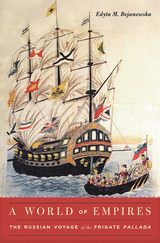
A Financial Times Best History Book of the Year
Many people are familiar with American Commodore Matthew Perry’s expedition to open trade relations with Japan in the early 1850s. Less well known is that on the heels of the Perry squadron followed a Russian expedition secretly on the same mission. Serving as secretary to the naval commander was novelist Ivan Goncharov, who turned his impressions into a book, The Frigate Pallada, which became a bestseller in imperial Russia. In A World of Empires, Edyta Bojanowska uses Goncharov’s fascinating travelogue as a window onto global imperial history in the mid-nineteenth century.
Reflecting on encounters in southern Africa’s Cape Colony, Dutch Java, Spanish Manila, Japan, and the British ports of Singapore, Hong Kong, and Shanghai, Goncharov offers keen observations on imperial expansion, cooperation, and competition. Britain’s global ascendancy leaves him in equal measures awed and resentful. In Southeast Asia, he recognizes an increasingly interlocking world in the vibrant trading hubs whose networks encircle the globe. Traveling overland back home, Goncharov presents Russia’s colonizing rule in Siberia as a positive imperial model, contrasted with Western ones.
Slow to be integrated into the standard narrative on European imperialism, Russia emerges here as an increasingly assertive empire, eager to position itself on the world stage among its American and European rivals and fully conversant with the ideologies of civilizing mission and race. Goncharov’s gripping narrative offers a unique eyewitness account of empire in action, in which Bojanowska finds both a zeal to emulate European powers and a determination to define Russia against them.

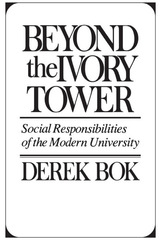

What is distinctive, Derek Bok asks, about the American system of higher education, and how well does it perform? In particular, just how good is the education our universities offer? Are they doing all they can to educate their students, or do teaching and learning get lost in the pressure for ever more prestigious research and publication? Bok concludes that the competition characteristic of American higher education—competition for the best students, the most advanced scholarship, the most successful scientific research, the best facilities—has helped to produce venturesome, adaptable, and varied universities. But because the process of learning itself is imperfectly understood, it is difficult to achieve sustained progress in the quality of education or even to determine which educational innovations actually enhance learning.
Despite these problems, the last fifteen years have produced many promising developments, such as experimental curricula, computer-assisted learning, much-expanded offerings for nontraditional students, clinical legal education, schools of public policy to prepare students for public service careers, and many more. Such initiatives need a more secure and central place within the regular curriculum. In addition to the traditional focus on program and curriculum, Bok stresses the need to pay greater attention to improving the effectiveness of teaching and learning. He calls for a number of steps, including a sustained program of research directed toward evaluating educational programs and methods of teaching. Only through careful experimentation and evaluation of its own efforts, through many small improvements and occasional inspired advances, can each university move toward the goal of giving its students the best possible preparation for life in an increasingly complex world.
READERS
Browse our collection.
PUBLISHERS
See BiblioVault's publisher services.
STUDENT SERVICES
Files for college accessibility offices.
UChicago Accessibility Resources
home | accessibility | search | about | contact us
BiblioVault ® 2001 - 2024
The University of Chicago Press









